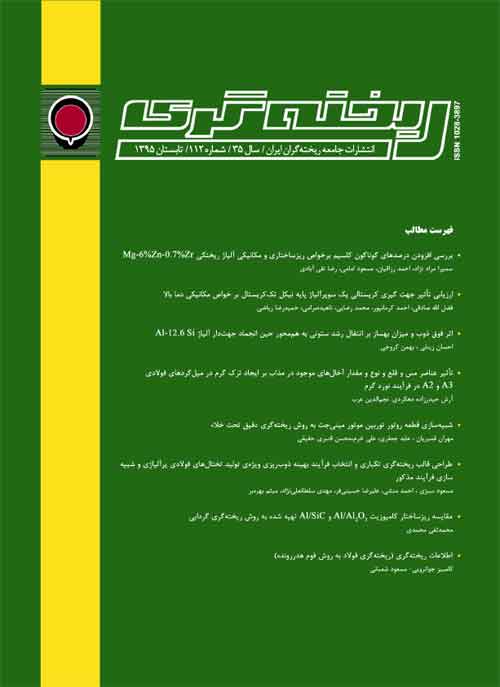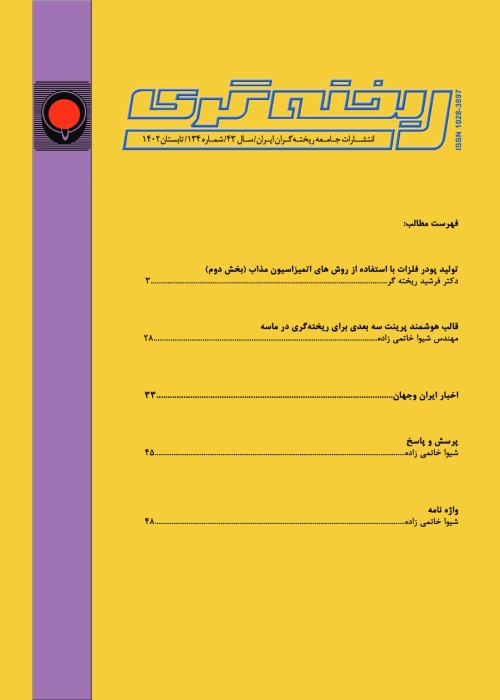فهرست مطالب

نشریه ریخته گری
پیاپی 112 (تابستان 1395)
- تاریخ انتشار: 1395/06/30
- تعداد عناوین: 8
-
-
بررسی افزودن درصدهای گوناگون کلسیم برخواص ریزساختاری و مکانیکی آلیاژ ریختگی Mg-6%Zn-0. 7%Zrصفحه 2
-
ارزیابی تاثیر جهت گیری کریستالی یک سوپرآلیاژ پایه نیکل تک کریستال بر خواص مکانیکی دما بالاصفحه 11
-
اثر فوق ذوب و میزان بهساز بر انتقال رشد ستونی به هم محور حین انجماد جهت دار آلیاژ Al-12. 6Siصفحه 17
-
تاثیر عناصر مس و قلع و نوع و مقدار آخال های موجود در مذاب بر ایجاد ترک گرم در میل گردهای فولادی A3 و A2 در فرآیند نورد گرمصفحه 22
-
شبیه سازی قطعه روتور توربین موتور مینی جت به روش ریخته گری دقیق تحت خلاءصفحه 30
-
طراحی قالب ریخته گری تکباری و انتخاب فرآیند بهینه ذوب ریزی ویژه ی تولید تختال های فولادی پرآلیاژی و شبیه سازی فرآیند مذکورصفحه 38
-
مقایسه ریزساختار کامپوزیت Al/Al2O3 و Al/SiC تهیه شده به روش ریخته گری گردابیصفحه 44
-
ریخته گری فولاد به روش فوم هدررونده (ترجمه مقاله مجله Modern Casing October 2016)صفحه 50
-
Single Stage Semi-Solid Casting of Gray Cast Iron in a Sand MoldPage 2In current study, effect of different content of calcium on the microstructure and mechanical properties of commercial ZK60 alloy is investigated. Micrographs of as-cast alloys were observed by optical and SEM microscopy. Experimental results show that the calcium addition was to be active in the refining of the grains of as-cast specimens by use of GRF mechanism. The tensile properties of the alloys increased from 149 to 220 MPa for base and ZK60%Ca alloy. Evaluation of the fracture surface of the base alloy showed that the modification process by calcium up to 3 percent change the ductile mechanisms of failure, to brittle mode.Keywords: Calcium, as cast, tensile properties, microstructure, mechanical properties
-
Investigating the effect of crystal orientation of a Ni-based single crystal super alloy on high temperature mechanical propertiesPage 11Ni-based super alloys have drawn an inordinate attention over the past years utilized as turbine blades of landbased gas turbines by many researchers around the world. Anisotropic mechanical properties of the single crystal super alloys at high temperature are one of their important practical characteristics. The research showed that microstructural parameters significantly influence the desired mechanical properties of single crystal super alloys. The angular deviation of the single crystal relative to longitudinal axis of the blade is one of these parameters. Electron Back Scattered Diffraction (EBSD) and Laue diffractometer are methods that can precisely measure misorientation of the single crystals. In this paper, the rotating orientation X-ray diffraction (RO-XRD) method was developed to measure the crystal orientation of the single crystal specimens using a monochromatic X-ray. The effect of crystal misorientation high temperature mechanical properties of the heat treated samples was investigated. Results showed that rupture life of the single crystal specimens were dependent upon crystal misorientation such that a higher misorientation resulted in a lower rupture life.Keywords: Single crystal super alloy, Crystal misorientation, Stress rupture properties
-
Effects of superheating and modification level on columnar to equiaxedtransition during directional solidification of Al-12.6Si alloyPage 17In this paper effects of superheating and modification level (ML) with Sr during directional solidification of Al- Si eutectic alloy was investigated. Eutectic alloy after melt at 800˚C was modified with 70,120 and 500 ppm Sr. after modification treatment, melt was cooled till reach considered super heating with 13,53 and 83˚C to start directional solidification. Temperature of each sample was taken at 6 points in the melt with respect to directional solidification. Longitudinal sections of directional solidification samples were analyzed and information dealing with temperature measurement and position of Columnar to Equiaxed Transition (CET) investigated for each sample. The results shows increasing in modification level and superheating at same time would increase in columnar zone length.Keywords: Al-Si eutectic alloy, Modification Level (ML), Columnar to EquiaxedTransition (CET), Melt supercooling
-
The effect of Cu, Sn, type and amount of inclusions in molten steel on hot shortness in rebar of A3 and A2 in hot rollingPage 22In this research to study the effect of the Cu and Sn at the hot working properties, prepared two samples of rebar with and without crack on them. To specification chemical composition optical emission spectroscopy and XRF tests have been used. The cracked sample had more amount of Cu and Sn and less Ni than the other one in its composition. Cu and Sn elements cause the sensitivity to hot shortness in the cracked sample; also low amount of Ni in this steel could not justify the harmful effect of the Cu and Sn. To identify the microstructure of two samples used optical microscope and the observes showed that these samples had two phases of ferrite and perlite. The amount of ferrite phase in the cracked sample was more than the other one and it was because of inclusions in this samples and consequently increasing the nucleation places for ferrite phase. Studying microstructure of billet 5sp sample showed that this sample had ferrite-perlite phase, but because of more amount of Cu and Sn in this sample more percent of perlite phase was seen. To study the inclusions of the 5sp sample it used the SEM that equipped by EDS analyze. The observes of EDS analyze showed Mn and Ca elements in the conclusions that made because of Desulfurization in the steel melt. To study the effect of gas pump by the Prussia plug methods it used nitrogen and argon gases. The optimal mechanical properties with nitrogen pump was achieved at 3.5 bar and 5 minutes. Also the optimal physical properties with argon pump achieved at 3 bar and 5 minutes.Keywords: Hot working, Hot Shortness, A3 rebar, Copper, Tin
-
The numerical simulation of mini jet engine turbine rotor using VIM processPage 30In this research, the investment casting process of IN-100 mini jet engine turbine rotor has been simulated by ProCast software. Based on this simulation, the proper filling system were designed and probability of shrinkage porosity and hot tear occurring were measured. Hence, the three pouring temperatures of 1400°, 1475°, and 1550°C were selected in order to investigate these parameters. Then, using data extracted from simulation, the effective stress and cooling curves in different sections of material were analyzed.Keywords: Casting simulation, Investment casting, Mini jet turbine rotor, In-100 alloy
-
Batch type Casting Mold Design and Optimal Pouring Process selection, Specially for High-Alloy Steel Slabs Production and the Simulation of Mentioned ProcessPage 38The aim of this study was mold design for batch type casting and selection of optimal pouring process, especially for high-alloy steel slabs production with dimensions 1500×3200×150-300mm and the simulation for validation of mentioned process. For this purpose, initially a metallic mold (water cooled copper) with dimensions 4000 × 2000 × 150-300 mm was designed. Then, batch type mold design and pouring optimization process were simulated by Procast casting software. It is noteworthy that for the slab casting process simulation, thicknesses of 150 and 300 mm were considered. Also for high-alloy steels family, Hadfield manganese austenitic steel were considered. The results showed that the use of copper mold for steel slabs casting of high-alloy steels provided satisfactory results. The results showed that by increasing the thickness of high- alloy steels slabs from 150 mm to 300 mm, amount of gas and contraction cavities, solidification time, melt turbulence, the number of slab hot spots and the time necessary to achieve the melt to solidus line all increased and in contrast, the solidification rate decreased. Also the study had shown that the majority of pores created in both low and high- alloy steels slabs occurred in the slab surfaces and these gas and contraction cavities are primarily shapeless.Keywords: steel slabs, mold design, batch type casting, metallurgical properties, casting defects
-
Comparison the microstructure of the composites Al/Al2O3 and Al/ SiC fabricated by stir casting methodPage 44In this study, Al/Al2O3 and Al/SiC composites were fabricate by string casting method, then the obtained microstructure was evaluated.A356 Alloy as matrix and Al2O3 and SiC particles as reinforcement with volume fraction of 5% and the size of 0.1-3 micrometer were chosen. The effective parameters on stirring casting process such as: speed and stirring time, figure and dimension of impeller, the height of impeller the bottom of ladle, the addition of particles to the molten and conditions introduce particles molten and etc. were taken into consideration efficiently and based on previous studies of researchers. Optical and scanning electron microscope equipped with EDS and X-RAY map scan was used for studying microstructures.OM figures showed that reinforcement particles have homogenous and uniform distribution on matrix and the microstructure of non-dendrite composite was distinct and globular. SEM figures illustrated that the reinforcement particles are distributed in inter-grain spaces, holes, shrinkages, porosities, grain boundaries. X-ray map scan results confirmed the diffusion of Carbon and silicon atoms in the interface with Aluminum and the contact formation with proper contact angle, while alumina particles are more stable in comparison with molten ones. XRD model confirmed the presence of reinforcing particles on matrix and didnt report any destructive reaction on matrix-particle interface.Keywords: microstructure, stirring casting, interface, reinforcement
-
The Case for Steel Lost Foam Casting, October 2016 MODERN CASTINGPage 50


